For our tour description, itinerary,
past triplists, dates, fees, and more, please VISIT OUR TOUR PAGE.
See this triplist in printable PDF format with media only on
page 1.
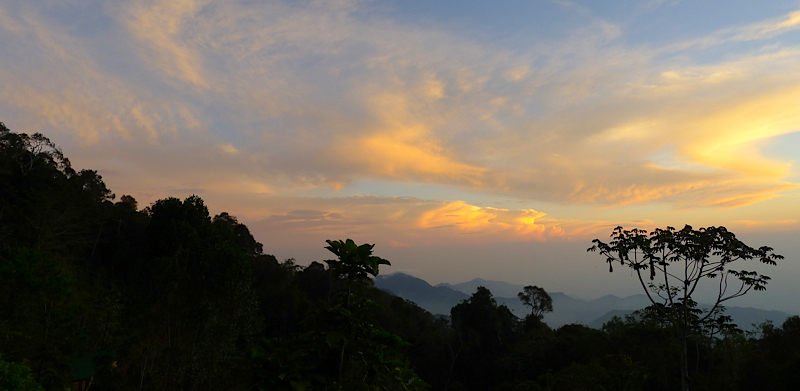
We ended our days
at ProAves' El Dorado lodge with a relaxing evening on the
deck, enjoying this lovely sunset after checking the compost
for wood-quail and brush-finches, while watching the feeders
for something new among the throng of regular beauties.
(Photo by guide Richard Webster)
Arriving in Barranquilla's airport provides no indication
that one might be close to Colombia's highest peaks, and the
first couple of days are certainly well removed from the
visions of a lush Sierra that probably motivated your trip.
But on departure from Barranquilla eight days later, your mind
was certainly full of memories of mountain views and rich and
varied birding.
The first couple of days, while not on the lush side of the
spectrum, were fun birding. We even enjoyed lunch on the
beach, an opportunity to take a photo to pretend you had a
standard Caribbean vacation! We started birding with one of
our best pieces of luck, Chestnut-winged Chachalacas on the
outskirts of Barranquilla, and continued onto Isla Salamanca
and the national park of the same name. A quick slice of land
and water birds included Snail Kite, Limpkin, Russet-throated
Puffbird, Pale-legged Hornero, and Bronzed (Bronze-brown)
Cowbird, after which we moved quickly to the mangroves of Los
Cocos. Here we saw our first Chestnut Piculets and were most
fortunate to see several Sapphire-bellied Hummingbirds, a
poorly known and Critically Endangered species.
By the afternoon we had moved far east to Riohacha and the
arid lowlands that mark the beginning of the Guajira
Peninsula. Birding the dry woodlands and rainwater ponds
around Camarones that evening and the next morning provided
views of most of the regional specialties, particularly
including Vermilion Cardinal, the beautiful White-whiskered
Spinetail, glowing Red-billed Emeralds, dingy Buffy
Hummingbirds, Bare-eyed Pigeon, Slender-billed Tyrannulet, and
Glaucous Tanager. The special bonus was a pair of Tocuyo
Sparrows at close range, while the disappointment was limited
looks at Orinocan Saltator. The lagoon was regrettably
flamingo free, but had a variety of waterbirds, including a
few Scarlet Ibis.
Moving to the foothills of the Sierra, we stayed in the small
community of Minca, where the hotel's feeders were jammed with
hummingbirds. Birding around the edges of town was very
productive, highlights including a surprise Collared
Forest-Falcon, Scaled Piculet, Black-backed Antshrike, and the
lovely Golden-winged Sparrow, among many widespread lowland
species such as Keel-billed Toucan.
En route to our home for four nights, ProAves' El Dorado
Lodge and Reserve, we found our first endemics in one of the
first wet ravines, Santa Marta Foliage-gleaner and Santa Marta
Tapaculo, followed by White-lored Warbler and Blossomcrown
around a garden at middle elevation. Our first evening at El
Dorado was highly memorable, with Santa Marta Antpitta on
schedule for worms, two endemic brush-finches in the feeding
tray, and White-tailed Starfrontlet at the feeders. Continued
evening birding around the lodge grounds the next several days
was to produce more of those plus several sightings of
Black-fronted Wood-Quail and Slaty-backed Nightingale-Thrush
attracted by the compost or worms, as well as roosting
Band-tailed Guans. An evening foray was lucky to obtain a
sighting of a perched screech-owl that is undescribed.
Clear views are not unexpected at this time of year, but we
were fortunate to have two CLEAR & CALM mornings on the
top of the San Lorenzo ridge. Even on good days, clear does
not last for long, but we were still able to enjoy good
birding most of the morning. Our first morning had two
especially exciting encounters: Santa Marta Parakeet and Santa
Marta Bush-Tyrant. Seeing Santa Marta Warbler was also a good
experience, and we further enjoyed easier endemics such as
Yellow-crowned Redstart and Black-cheeked (Santa Marta)
Mountain-Tanager. Much time was also invested in some
skulkers, with sightings of Rufous Antpitta, Brown-rumped
Tapaculo, and anachoreta Gray-breasted Wood-Wrens, a process
that was to continue two days later with better views of the
tapaculo and Rusty-headed Spinetail. Other great memories from
the ridge were of White-tipped Quetzal and Strong-billed
Woodcreeper.
We also went downslope from the lodge on two mornings, seeing
several parrots and parakeets, Santa Marta Woodstar,
Groove-billed Toucanet, Masked Trogon, Rusty-breasted
Antpitta, Golden-breasted Fruiteater, and several thrushes,
while improving views of Santa Marta Tapaculo and White-lored
Warbler.There was also a taste of the spring that is coming to
our homes shortly: many birds that breed in North America were
wintering in Colombia, and we enjoyed some birds in spring
finery, such as Blackburnian Warbler and Scarlet Tanager.
Mammals were few, and actually more than normal, including
sightings of two primates, Night Monkey and (Venezuelan) Red
Howler.
Those fine dawn views of the Sierra were views out over a
landscape that has been greatly altered over the centuries.
BirdLife estimates that only 15% of the Sierra's original
vegetation is intact. Evidence of changes in this region are
reflected in the conservation status of the species we saw: 1
Critically Endangered, 2 Endangered, 5 Vulnerable, and 3 Near
Threatened.
Our tour was made easy by the efforts of many EcoTurs staff
and helpers, from Adela, Anna, and Flor in the kitchen at El
Dorado, Lorenzo on the grounds, hard-working volunteers like
Sam, and several competent and patient drivers like Montero,
Jorge, and Virgilio.
The taxonomy tries to follow the recent Clements (Cornell)
changes. Conservation information is drawn from the
publications of BirdLife International. Apologies to the
Spanish language for omitting certain punctuation marks that
do not survive cross-platform computer usage.
--Richard
KEYS FOR THIS LIST
One of the following keys may be shown in brackets for
individual species as appropriate: * = heard only, I =
introduced, E = endemic, N = nesting, a = austral migrant, b =
boreal migrant
Tinamidae (Tinamous)
GRAY TINAMOU (Tinamus tao) [*]
Anatidae (Ducks, Geese, and Waterfowl)
BLUE-WINGED TEAL (Anas discors) [b]
Cracidae (Guans, Chachalacas, and
Curassows)
CHESTNUT-WINGED CHACHALACA (Ortalis garrula) [E]
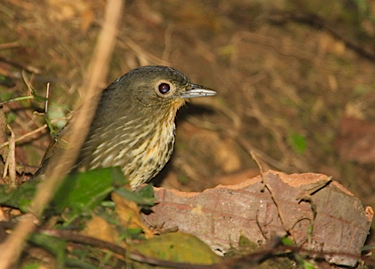
Santa Marta
Antpitta had been intermittently AWOL at the feeding
sessions, but we were fortunate to be back in the groove
on our first attempt at El Dorado, and it was seen again
on subsequent evenings, though not on schedule. (Photo by
guide Richard Webster)
RUFOUS-VENTED CHACHALACA (RUFOUS-VENTED)
(Ortalis ruficauda ruficrissa) [*]
BAND-TAILED GUAN
(Penelope argyrotis)
SICKLE-WINGED GUAN
(Chamaepetes goudotii)
Odontophoridae (New World Quail)
BLACK-FRONTED WOOD-QUAIL (Odontophorus atrifrons)
Fregatidae (Frigatebirds)
MAGNIFICENT FRIGATEBIRD (Fregata magnificens)
Phalacrocoracidae (Cormorants and Shags)
NEOTROPIC CORMORANT (Phalacrocorax brasilianus)
Pelecanidae (Pelicans)
BROWN PELICAN (Pelecanus occidentalis)
Ardeidae (Herons, Egrets, and Bitterns)
GREAT BLUE HERON (Ardea herodias) [b]
COCOI HERON
(Ardea cocoi)
GREAT EGRET
(Ardea alba)
SNOWY EGRET
(Egretta thula)
LITTLE BLUE HERON
(Egretta caerulea)
TRICOLORED HERON
(Egretta tricolor)
REDDISH EGRET
(Egretta rufescens)
CATTLE EGRET
(Bubulcus ibis)
STRIATED HERON
(Butorides striata)
YELLOW-CROWNED
NIGHT-HERON (Nyctanassa
violacea)
Threskiornithidae (Ibises and Spoonbills)
WHITE IBIS (Eudocimus
albus)
SCARLET IBIS
(Eudocimus ruber)
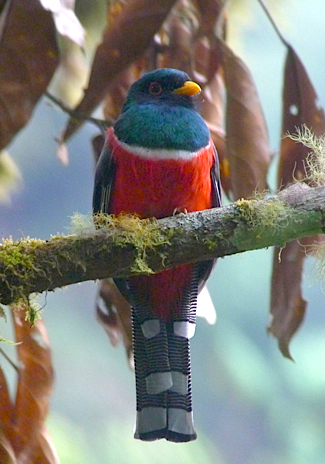
In addition to
the many Santa Marta endemics, there are a number of
distinctive subspecies, such as this sanctaemartae Masked
Trogon. With further study (it has a longer song than
Andean subspecies), some of these may yet be elevated to
species status. (Photo by guide Richard Webster)
GLOSSY IBIS (Plegadis falcinellus)
BARE-FACED IBIS
(Phimosus infuscatus)
ROSEATE SPOONBILL
(Platalea ajaja)
Cathartidae (New World Vultures)
BLACK VULTURE (Coragyps atratus)
TURKEY VULTURE
(Cathartes aura)
LESSER
YELLOW-HEADED VULTURE (Cathartes
burrovianus)
KING VULTURE
(Sarcoramphus papa)
Pandionidae (Osprey)
OSPREY (Pandion
haliaetus) [b]
Accipitridae (Hawks, Eagles, and Kites)
PEARL KITE (Gampsonyx
swainsonii)
SNAIL KITE
(Rostrhamus sociabilis)
PLUMBEOUS KITE
(Ictinia plumbea)
BLACK-COLLARED
HAWK (Busarellus nigricollis)
SAVANNA HAWK
(Buteogallus meridionalis)
HARRIS'S HAWK
(Parabuteo unicinctus)
BROAD-WINGED HAWK
(Buteo platypterus) [b]
GRAY HAWK (Buteo nitidus)
BLACK HAWK-EAGLE
(Spizaetus tyrannus)
Falconidae (Falcons and Caracaras)
BARRED FOREST-FALCON (Micrastur ruficollis)
COLLARED
FOREST-FALCON (Micrastur
semitorquatus)
CRESTED CARACARA
(Caracara cheriway)
YELLOW-HEADED
CARACARA (Milvago chimachima
chimachima)
AMERICAN KESTREL
(Falco sparverius)
BAT FALCON
(Falco rufigularis)
PEREGRINE FALCON
(Falco peregrinus)
Rallidae (Rails, Gallinules, and Coots)
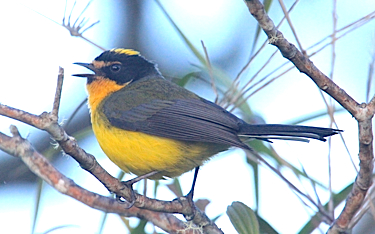
One of the
livelier (hence easier) endemics is the Yellow-crowned
Redstart (Whitestart), a frequently-heard songster of the
upper elevations on the San Lorenzo ridge. (Photo by guide
Richard Webster)
PURPLE GALLINULE (Porphyrio martinica)
COMMON GALLINULE
(Gallinula galeata)
Aramidae (Limpkin)
LIMPKIN (Aramus
guarauna)
Charadriidae (Plovers and Lapwings)
SOUTHERN LAPWING (Vanellus chilensis)
BLACK-BELLIED
PLOVER (Pluvialis squatarola)
[b]
SEMIPALMATED
PLOVER (Charadrius
semipalmatus) [b]
Haematopodidae (Oystercatchers)
AMERICAN OYSTERCATCHER (Haematopus palliatus)
Recurvirostridae (Stilts and Avocets)
BLACK-NECKED STILT (Himantopus mexicanus)
Jacanidae (Jacanas)
WATTLED JACANA (Jacana jacana)
Scolopacidae (Sandpipers and Allies)
SPOTTED SANDPIPER (Actitis macularius) [b]
SOLITARY SANDPIPER
(Tringa solitaria) [b]
GREATER YELLOWLEGS
(Tringa melanoleuca)
WILLET (Tringa semipalmata) [b]
LESSER YELLOWLEGS
(Tringa flavipes) [b]
WHIMBREL (Numenius phaeopus)
[b]
SANDERLING
(Calidris alba) [b]
WESTERN SANDPIPER
(Calidris mauri)
[b]
LEAST SANDPIPER
(Calidris minutilla)
[b]
Laridae (Gulls, Terns, and Skimmers)
LAUGHING GULL (Leucophaeus atricilla)
GULL-BILLED TERN
(Gelochelidon nilotica)
COMMON TERN
(Sterna hirundo)
ROYAL TERN
(Thalasseus maximus)
SANDWICH TERN
(Thalasseus sandvicensis)
Columbidae (Pigeons and Doves)
ROCK PIGEON (Columba livia)
[I]
PALE-VENTED PIGEON
(Patagioenas cayennensis)
SCALED PIGEON
(Patagioenas speciosa)
BARE-EYED PIGEON
(Patagioenas corensis)
BAND-TAILED PIGEON
(WHITE-NECKED) (Patagioenas
fasciata albilinea)
COMMON GROUND-DOVE
(Columbina passerina)
RUDDY GROUND-DOVE
(Columbina talpacoti)
SCALED DOVE
(Columbina squammata)
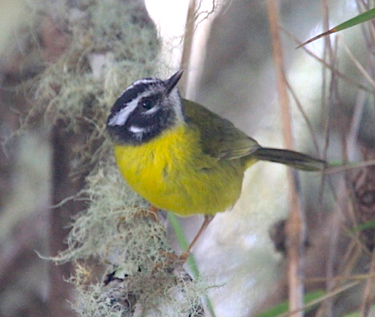
Always a bit of a
challenge, the endemic Santa Marta Warbler occurs in small
groups deep down in the large bamboo clumps of the upper
San Lorenzo ridge. (Photo by guide Richard Webster)
BLUE GROUND-DOVE (Claravis pretiosa)
WHITE-TIPPED DOVE
(Leptotila verreauxi)
LINED QUAIL-DOVE
(Geotrygon linearis)
Psittacidae (Parrots)
SANTA MARTA PARAKEET (Pyrrhura viridicata)
[E]
SCARLET-FRONTED
PARAKEET (Aratinga wagleri
wagleri)
BROWN-THROATED
PARAKEET (Aratinga pertinax)
GREEN-RUMPED
PARROTLET (Forpus passerinus)
ORANGE-CHINNED
PARAKEET (Brotogeris
jugularis)
BLUE-HEADED PARROT
(Pionus menstruus)
RED-BILLED PARROT
(Pionus sordidus saturatus)
SCALY-NAPED PARROT
(Amazona mercenaria)
Cuculidae (Cuckoos)
SQUIRREL CUCKOO (Piaya cayana)
STRIPED CUCKOO
(Tapera naevia)
GREATER ANI
(Crotophaga major)
SMOOTH-BILLED ANI
(Crotophaga ani)
GROOVE-BILLED ANI
(Crotophaga sulcirostris)
Strigidae (Owls)
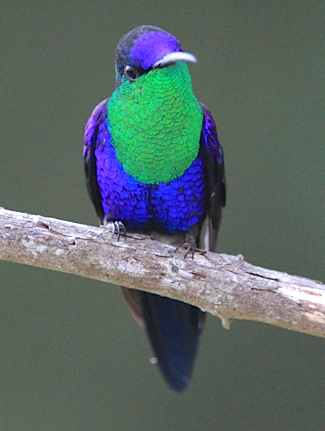
One of the joys
of our time at the El Dorado lodge was enjoying these
stunning Violet-crowned Woodnymphs at the feeders--always
present, always glowing. (Photo by guide Richard Webster)
SCREECH-OWL SP. NOV. (Megascops sp. nov.)
FERRUGINOUS
PYGMY-OWL (Glaucidium
brasilianum)
MOTTLED OWL
(Ciccaba virgata) [*]
Caprimulgidae (Nightjars and Allies)
LESSER NIGHTHAWK (Chordeiles acutipennis)
BAND-WINGED
NIGHTJAR (Caprimulgus
longirostris)
Apodidae (Swifts)
CHESTNUT-COLLARED SWIFT (Streptoprocne rutila)
WHITE-COLLARED
SWIFT (Streptoprocne zonaris)
LESSER
SWALLOW-TAILED SWIFT (Panyptila
cayennensis)
Trochilidae (Hummingbirds)
WHITE-NECKED JACOBIN (Florisuga mellivora)
RUFOUS-BREASTED
HERMIT (Glaucis hirsutus)
PALE-BELLIED
HERMIT (Phaethornis
anthophilus)
SOOTY-CAPPED
HERMIT (Phaethornis augusti)
BROWN VIOLETEAR
(Colibri delphinae)
GREEN VIOLETEAR
(Colibri thalassinus)
BLACK-THROATED
MANGO (Anthracothorax
nigricollis)
BLOSSOMCROWN
(Anthocephala floriceps) [E]
TYRIAN METALTAIL
(Metallura tyrianthina districta)
WHITE-TAILED
STARFRONTLET (Coeligena
phalerata) [E]
LONG-BILLED
STARTHROAT (Heliomaster
longirostris)
SANTA MARTA
WOODSTAR (Chaetocercus
astreans) [E]
RED-BILLED EMERALD
(Chlorostilbon gibsoni nitens)
COPPERY EMERALD
(Chlorostilbon russatus)
WHITE-VENTED
PLUMELETEER (Chalybura
buffonii)
VIOLET-CROWNED
WOODNYMPH (Thalurania
colombica)
BUFFY HUMMINGBIRD
(Leucippus fallax)
STEELY-VENTED
HUMMINGBIRD (Amazilia
saucerrottei)
RUFOUS-TAILED
HUMMINGBIRD (Amazilia tzacatl)
SAPPHIRE-BELLIED
HUMMINGBIRD (Lepidopyga
lilliae)
WHITE-CHINNED
SAPPHIRE (Hylocharis cyanus)
Trogonidae (Trogons)
WHITE-TIPPED QUETZAL (Pharomachrus fulgidus)
MASKED TROGON
(Trogon personatus sanctaemartae)
Momotidae (Motmots)
WHOOPING MOTMOT (Momotus subrufescens)
Alcedinidae (Kingfishers)
RINGED KINGFISHER (Megaceryle torquata)
AMAZON KINGFISHER
(Chloroceryle amazona)
GREEN KINGFISHER
(Chloroceryle americana)
AMERICAN PYGMY
KINGFISHER (Chloroceryle
aenea)
Bucconidae (Puffbirds)
RUSSET-THROATED PUFFBIRD (Hypnelus ruficollis)
Galbulidae (Jacamars)
RUFOUS-TAILED JACAMAR (Galbula ruficauda)
Ramphastidae (Toucans)
EMERALD TOUCANET (SANTA MARTA) (Aulacorhynchus prasinus lautus)
GROOVE-BILLED
TOUCANET (YELLOW-BILLED) (Aulacorhynchus
sulcatus calorhynchus)
KEEL-BILLED TOUCAN
(Ramphastos sulfuratus)
Picidae (Woodpeckers)
SCALED PICULET (Picumnus squamulatus)
CHESTNUT PICULET
(Picumnus cinnamomeus)
RED-CROWNED
WOODPECKER (Melanerpes
rubricapillus) [N]
GOLDEN-OLIVE
WOODPECKER (Colaptes
rubiginosus)
SPOT-BREASTED
WOODPECKER (Colaptes
punctigula)
CRIMSON-CRESTED
WOODPECKER (Campephilus
melanoleucos)
Furnariidae (Ovenbirds and Woodcreepers)
GRAY-THROATED LEAFTOSSER (Sclerurus albigularis)
PALE-LEGGED
HORNERO (CARIBBEAN) (Furnarius
leucopus longirostris)
PALE-BREASTED
SPINETAIL (Synallaxis
albescens)
RUSTY-HEADED
SPINETAIL (Synallaxis
fuscorufa) [E]
WHITE-WHISKERED
SPINETAIL (Synallaxis candei)
STREAK-CAPPED
SPINETAIL (Cranioleuca
hellmayri)
YELLOW-CHINNED
SPINETAIL (Certhiaxis
cinnamomeus)
SPOTTED BARBTAIL
(Premnoplex brunnescens)
MONTANE
FOLIAGE-GLEANER (Anabacerthia
striaticollis anxia)
SANTA MARTA
FOLIAGE-GLEANER (Automolus
rufipectus) [E]
STREAKED XENOPS
(Xenops rutilans)
PLAIN-BROWN
WOODCREEPER (Dendrocincla
fuliginosa)
STRONG-BILLED
WOODCREEPER (Xiphocolaptes
promeropirhynchus)
STRAIGHT-BILLED
WOODCREEPER (Dendroplex picus)
STREAK-HEADED
WOODCREEPER (Lepidocolaptes
souleyetii)
MONTANE
WOODCREEPER (Lepidocolaptes
lacrymiger sanctaemartae)
Thamnophilidae (Typical Antbirds)
BLACK-CRESTED ANTSHRIKE (Sakesphorus canadensis)
BARRED ANTSHRIKE
(Thamnophilus doliatus)
WESTERN
SLATY-ANTSHRIKE (Thamnophilus
atrinucha)
BLACK-BACKED
ANTSHRIKE (Thamnophilus
melanonotus)
WHITE-FRINGED
ANTWREN (Formicivora grisea)
LONG-TAILED
ANTBIRD (Drymophila caudata)
Grallariidae (Antpittas)
SANTA MARTA ANTPITTA (Grallaria bangsi) [E]
RUFOUS ANTPITTA
(Grallaria rufula spatiator)
RUSTY-BREASTED
ANTPITTA (RUSTY-BREASTED) (Grallaricula
ferrugineipectus ferrugineipectus)
Rhinocryptidae (Tapaculos)
SANTA MARTA TAPACULO (Scytalopus sanctaemartae) [E]
BROWN-RUMPED
TAPACULO (Scytalopus
latebricola)
[E]
Tyrannidae (Tyrant Flycatchers)
SOUTHERN BEARDLESS-TYRANNULET (Camptostoma obsoletum)
WHITE-THROATED
TYRANNULET (Mecocerculus
leucophrys)
GREENISH ELAENIA
(Myiopagis viridicata)
YELLOW-BELLIED
ELAENIA (Elaenia flavogaster)
MOUNTAIN ELAENIA
(Elaenia frantzii)
OLIVE-STRIPED
FLYCATCHER (Mionectes
olivaceus)
OCHRE-BELLIED
FLYCATCHER (Mionectes
oleagineus)
GOLDEN-FACED
TYRANNULET (GOLDEN-FACED) (Zimmerius
chrysops minimus)
NORTHERN
SCRUB-FLYCATCHER (Sublegatus
arenarum)
SLENDER-BILLED
TYRANNULET (Inezia
tenuirostris)
PALE-TIPPED
TYRANNULET (Inezia caudata)
PALE-EYED
PYGMY-TYRANT (Atalotriccus
pilaris)
PEARLY-VENTED
TODY-TYRANT (Hemitriccus
margaritaceiventer)
BLACK-THROATED
TODY-TYRANT (Hemitriccus
granadensis)
YELLOW-OLIVE
FLYCATCHER (SANTA MARTA) (Tolmomyias
sulphurescens exortivus)
YELLOW-BREASTED
FLYCATCHER (OCHRE-LORED) (Tolmomyias
flaviventris aurulentus)
CINNAMON
FLYCATCHER (Pyrrhomyias
cinnamomeus assimilis) [N]
TROPICAL PEWEE
(Contopus cinereus)
ACADIAN FLYCATCHER
(Empidonax virescens) [b]
WILLOW FLYCATCHER
(Empidonax traillii) [b]
BLACK PHOEBE
(Sayornis nigricans)
VERMILION
FLYCATCHER (Pyrocephalus
rubinus)
SANTA MARTA
BUSH-TYRANT (Myiotheretes
pernix) [E]
PIED WATER-TYRANT
(Fluvicola pica)
YELLOW-BELLIED
CHAT-TYRANT (Ochthoeca
diadema)
CATTLE TYRANT
(Machetornis rixosa)
BRIGHT-RUMPED
ATTILA (Attila spadiceus)
[*]
DUSKY-CAPPED
FLYCATCHER (Myiarchus
tuberculifer)
PANAMA FLYCATCHER
(Myiarchus panamensis)
GREAT CRESTED
FLYCATCHER (Myiarchus
crinitus)
[*]
BROWN-CRESTED
FLYCATCHER (Myiarchus
tyrannulus)
GREAT KISKADEE
(Pitangus sulphuratus)
BOAT-BILLED
FLYCATCHER (Megarynchus
pitangua)
RUSTY-MARGINED
FLYCATCHER (Myiozetetes
cayanensis)
SOCIAL FLYCATCHER
(Myiozetetes similis)
GOLDEN-CROWNED
FLYCATCHER (Myiodynastes
chrysocephalus)
STREAKED
FLYCATCHER (Myiodynastes
maculatus)
PIRATIC FLYCATCHER
(Legatus leucophaius)
TROPICAL KINGBIRD
(Tyrannus melancholicus)
GRAY KINGBIRD
(Tyrannus dominicensis) [b]
FORK-TAILED
FLYCATCHER (Tyrannus savana)
Cotingidae (Cotingas)
GOLDEN-BREASTED FRUITEATER (Pipreola aureopectus)
RED-CRESTED
COTINGA (Ampelion
rubrocristatus)
Pipridae (Manakins)
WHITE-BEARDED MANAKIN (Manacus manacus)
Tityridae (Tityras and Allies)
MASKED TITYRA (Tityra semifasciata)
CINEREOUS BECARD
(Pachyramphus rufus)
Vireonidae (Vireos)
BROWN-CAPPED VIREO (Vireo leucophrys)
RED-EYED VIREO
(Vireo olivaceus) [b]
SCRUB GREENLET
(Hylophilus flavipes)
GOLDEN-FRONTED
GREENLET (Hylophilus
aurantiifrons)
Corvidae (Crows, Jays, and Magpies)
BLACK-CHESTED JAY (Cyanocorax affinis)
Hirundinidae (Swallows)
SOUTHERN ROUGH-WINGED SWALLOW (Stelgidopteryx ruficollis)
GRAY-BREASTED
MARTIN (Progne chalybea)
WHITE-WINGED
SWALLOW (Tachycineta
albiventer)
BARN SWALLOW
(Hirundo rustica)
[b]
Troglodytidae (Wrens)
STRIPE-BACKED WREN (Campylorhynchus nuchalis)
BICOLORED WREN
(Campylorhynchus griseus)
RUFOUS-BREASTED
WREN (Pheugopedius rutilus)
RUFOUS-AND-WHITE
WREN (Thryophilus rufalbus)
BUFF-BREASTED WREN
(Cantorchilus leucotis)
HOUSE WREN
(SOUTHERN) (Troglodytes aedon
musculus)
GRAY-BREASTED
WOOD-WREN (Henicorhina
leucophrys anachoreta)
GRAY-BREASTED
WOOD-WREN (Henicorhina
leucophrys bangsi)
Polioptilidae (Gnatcatchers)
LONG-BILLED GNATWREN (Ramphocaenus melanurus)
TROPICAL
GNATCATCHER (TROPICAL) (Polioptila
plumbea plumbiceps)
Turdidae (Thrushes and Allies)
ORANGE-BILLED NIGHTINGALE-THRUSH
(Catharus aurantiirostris)
SLATY-BACKED
NIGHTINGALE-THRUSH (Catharus
fuscater)
YELLOW-LEGGED
THRUSH (Turdus flavipes)
PALE-BREASTED
THRUSH (Turdus leucomelas)
CLAY-COLORED
THRUSH (Turdus grayi)
BLACK-HOODED
THRUSH (Turdus olivater)
GREAT THRUSH
(Turdus fuscater)
WHITE-NECKED
THRUSH (Turdus albicollis)
Mimidae (Mockingbirds and Thrashers)
TROPICAL MOCKINGBIRD (Mimus gilvus)
Parulidae (New World Warblers)
NORTHERN WATERTHRUSH (Parkesia noveboracensis) [b]
BLACK-AND-WHITE
WARBLER (Mniotilta varia)
[b]
PROTHONOTARY
WARBLER (Protonotaria citrea)
[b]
TENNESSEE WARBLER
(Oreothlypis peregrina) [b]
AMERICAN REDSTART
(Setophaga ruticilla) [b]
BLACKBURNIAN
WARBLER (Setophaga fusca)
[b]
YELLOW WARBLER
(NORTHERN) (Setophaga petechia
aestiva) [b]
RUFOUS-CAPPED
WARBLER (Basileuterus
rufifrons)
GOLDEN-CROWNED
WARBLER (Basileuterus
culicivorus)
SANTA MARTA
WARBLER (Basileuterus
basilicus) [E]
WHITE-LORED
WARBLER (Myiothlypis
conspicillatus) [E]
SLATE-THROATED
REDSTART (Myioborus miniatus)
YELLOW-CROWNED
REDSTART (Myioborus
flavivertex) [E]
Coerebidae (Bananaquit)
BANANAQUIT (Coereba
flaveola)
Thraupidae (Tanagers and Allies)
BICOLORED CONEBILL (Conirostrum bicolor)
WHITE-LINED
TANAGER (Tachyphonus rufus)
CRIMSON-BACKED
TANAGER (Ramphocelus
dimidiatus)
BLUE-GRAY TANAGER
(Thraupis episcopus)
GLAUCOUS TANAGER
(Thraupis glaucocolpa)
PALM TANAGER
(Thraupis palmarum)
BLUE-CAPPED
TANAGER (Thraupis
cyanocephala)
BLACK-CHEEKED
MOUNTAIN-TANAGER (Anisognathus
melanogenys) [E]
BAY-HEADED TANAGER
(Tangara gyrola)
BLACK-CAPPED
TANAGER (Tangara heinei)
BLACK-HEADED
TANAGER (Tangara cyanoptera)
[N]
SWALLOW TANAGER
(Tersina viridis)
STREAKED SALTATOR
(Saltator striatipectus)
GRAYISH SALTATOR
(Saltator coerulescens)
ORINOCAN SALTATOR
(Saltator orenocensis)
BUFF-THROATED
SALTATOR (Saltator maximus)
Emberizidae (Buntings, Sparrows and
Allies)
BLUE-BLACK GRASSQUIT (Volatinia jacarina)
GRAY SEEDEATER
(Sporophila intermedia)
YELLOW-BELLIED
SEEDEATER (Sporophila
nigricollis)
THICK-BILLED
SEED-FINCH (Oryzoborus
funereus)
PARAMO SEEDEATER
(Catamenia homochroa oreophila)
BLACK-FACED
GRASSQUIT (Tiaris bicolor)
WHITE-SIDED
FLOWERPIERCER (Diglossa
albilatera)
RUSTY
FLOWERPIERCER (Diglossa
sittoides)
PILEATED FINCH
(Coryphospingus pileatus)
GOLDEN-WINGED
SPARROW (Arremon schlegeli)
SIERRA NEVADA
BRUSH-FINCH (Arremon
basilicus) [E]
TOCUYO SPARROW
(Arremonops tocuyensis)
SANTA MARTA
BRUSH-FINCH (Atlapetes
melanocephalus) [E]
RUFOUS-COLLARED
SPARROW (Zonotrichia capensis)
Cardinalidae (Cardinals and Allies)
SUMMER TANAGER (Piranga rubra) [b]
SCARLET TANAGER
(Piranga olivacea)
VERMILION CARDINAL
(Cardinalis phoeniceus)
ROSE-BREASTED
GROSBEAK (Pheucticus
ludovicianus) [b]
INDIGO BUNTING
(Passerina cyanea)
[b]
Icteridae (Troupials and Allies)
GREAT-TAILED GRACKLE (Quiscalus mexicanus)
CARIB GRACKLE
(Quiscalus lugubris)
SHINY COWBIRD
(Molothrus bonariensis)
BRONZED COWBIRD
(BRONZE-BROWN) (Molothrus
aeneus armenti)
YELLOW ORIOLE
(Icterus nigrogularis)
BALTIMORE ORIOLE
(Icterus galbula) [b]
CRESTED OROPENDOLA
(Psarocolius decumanus)
Fringillidae (Siskins, Crossbills, and
Allies)
TRINIDAD EUPHONIA (Euphonia trinitatis)
THICK-BILLED
EUPHONIA (Euphonia
laniirostris)
BLUE-NAPED
CHLOROPHONIA (Chlorophonia
cyanea)
NIGHT MONKEY SP.
(Aotus sp.)
RED HOWLER MONKEY
(Alouatta seniculus)
RED-TAILED
SQUIRREL (Sciurus granatensis)
SOUTH AMERICAN
COATI (Nasua nasua)
Other significant critters:
Iguana: at the edge of Barranquilla.
American Crocodile: Several were nesting at Los Cocos, and we
were warned not to walk a couple of paths. Several folks did
see the snout of one among the mangroves.
Basilisk: Seen on Isla Salamanca and along the small river
above Minca.
Dead snake in the road: Identified as the genus Chionurus.
Tree mouse sp.: Tonya has one.
Butterflies: Not huge numbers, but some nice selections, on
which Kristine is doubtless working with her photographs.
Totals for the tour: 300 bird taxa and 4 mammal taxa






